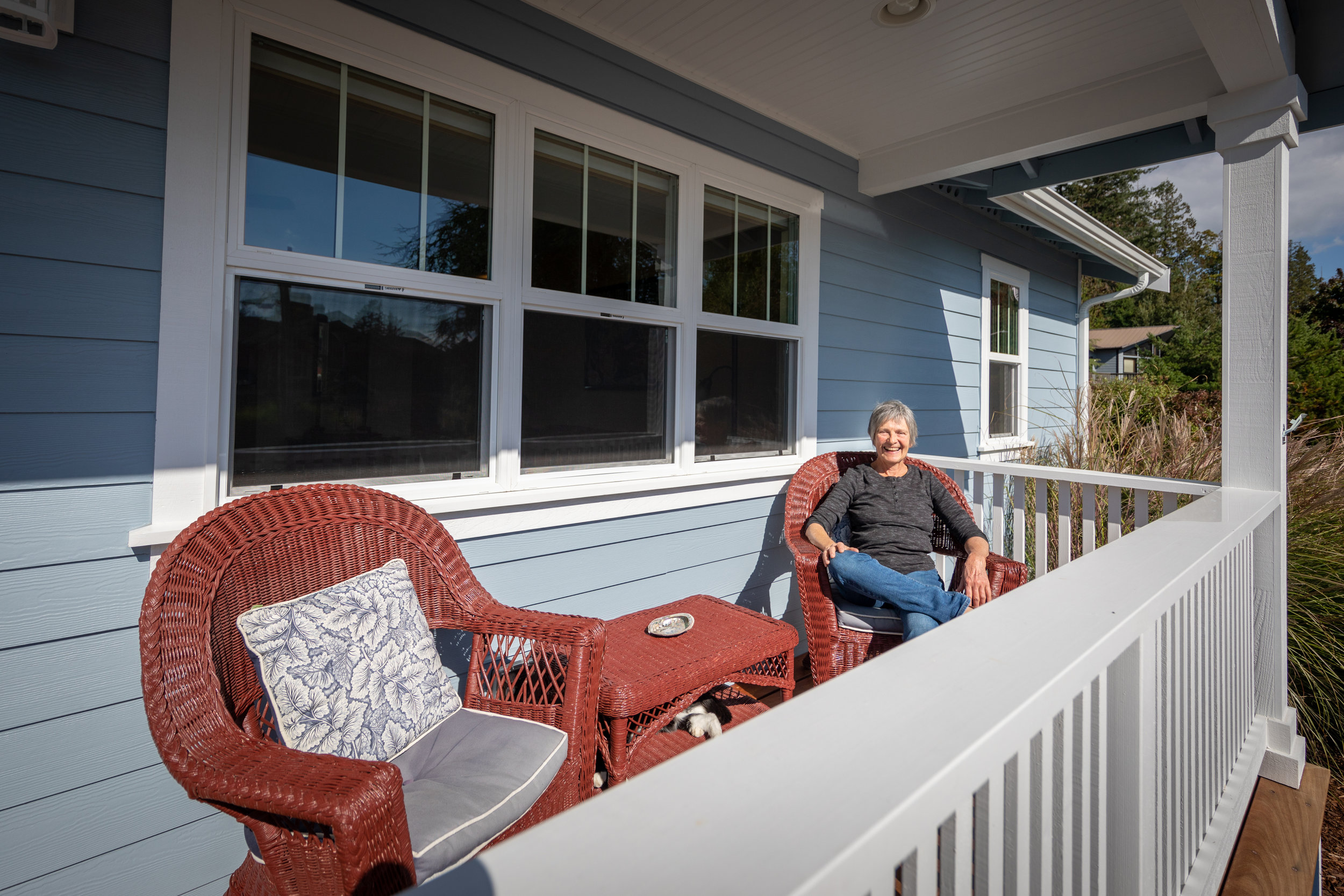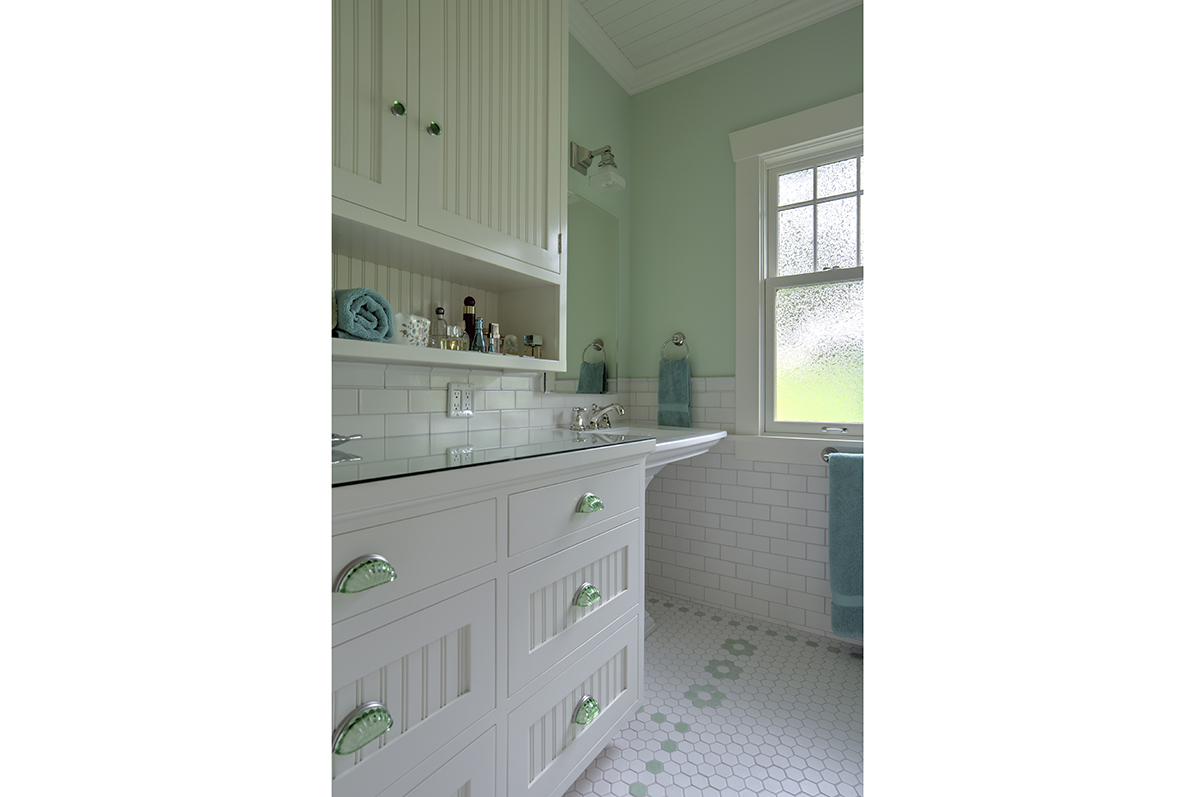Every A1 home starts with you.
We bring a keen sense of place and performance to a collaborative process aimed at creating a home that makes your life better. As you’ll see below, we are property preservation specialists, committed to ensuring that every home, whether renovating, remodeling or building new, is designed to love, and built to last.
“We wanted home to be our place to retreat.”


















She had a house. He lived in an apartment. When married, they wanted to live in an “ours” place. They also had a pretty good idea of what they wanted to create: a place that felt like a cabin and lived like a house that would serve them the rest of their lives.
“Our plan is that this is our last home. We wanted it to support our dreams and needs as we unfold into our elder years.”
That meant opting for town over county – the closer to neighbors and services — despite the draw of rural life. Rick and Cindi, A1’s former owners, spent their lives up to that point as activists and small-business owners, she the designer, he the builder, devoted to environmental and social causes close to home. Naturally, the house would use as few new resources as possible, minimize energy use and maintenance, and maximize light, reclaimed materials and local products.
And so it does, in about 1,300 square feet of cozy on a wooded, in-city lot, A1’s retired owners Rick and Cindi plan trips, tend a small garden, berries and fruit trees, make art, and watch the wildlife scurry by from a covered patio, or through generous, high quality windows in every room.
Here are the key sustainability strategies we employed:
Lifetime-warranty composition roofing
Unvented, conditioned crawlspace
Blown-in cellulose insulation
ICF exterior walls
Pre-colored exterior stucco over ICF
On-demand water heater
The subfloor doubles as the finish flooring.
No baseboard trim
FSC-certified framing and sheathing lumber
Salvaged lumber from Duluth Lumber
Used building materials from the RE Store
Low-VOC paints
Xeriscaping, permaculture principles and rain garden
“We designed the home to maximize our relationship with the land, to support our long-term relationship, for future grandchildren who will come for visits; for Cindi's love for puttering around out-of-doors; for assurance that we have done what we could to minimize our footprint on the earth.”
“I wanted a better tub. And a sauna.”









A better tub, and a sauna. Everyone has priorities, and these are two we’d be hard pressed to argue with. Other keys to Margarette Grant’s happiness in her new home? Lots of light, energy efficiency, original charm, a porch big enough for two.
“I wanted to keep the character, and I wanted a house that was put together and didn't require a lot of maintenance. And I wanted to minimize my impact on the environment.”
Located near Drayton Harbor, the home began life in 1947 as a beach cottage. Margarette purchased it in 2007 as a getaway and rental. When she decided to make it her year-round residence in 2015, she called A1.
“I liked the design/build aspect of A1 — I appreciated that they would take the process from beginning to end.”
Together, we created a vision of a cozy, light-filled sanctuary that unites Margarette’s eclectic style with the informal character of beach side living. While the basic plan of the home remained intact, a few key moves made space for the sauna (10-foot bump out in the rear of the house), improved function and flow (moved a bedroom entry) and brought in more light (opened kitchen to living room, added three windows and two solatubes).
After that, it was all a matter of out with the old, in with the new:
Windows, doors, wall insulation, drywall, paint
Kitchen cabinets and countertop
Appliances, fixtures and floors (except for salvageable fir in guestroom)
Electric on-demand water heater
Wood stove
Exterior siding, trim, front porch, roof
“A1 showed me the value of communication on projects like this — they had a really good way to make me part of the process.”
$55. That was the amount of Margarette’s biggest electric bill, after a year at her new address. Recently, she joined a work party group. Neighbors help each other out with household chores, using many hands to making light — and social — work. She had to think hard to come up with anything, although once her native landscape takes root, she expects there will be some upkeep.
In the meantime, this long time Nordic skier who took up alpine skiing more recently — “I’m a super senior!” — can spend more time this winter in the mountains. After which, that tub and sauna is going to feel just great.
South Hill garage










If there were a prize for having the most efficient, durable garage in the land, Paul Shelley could probably claim it. Which is great for many reasons, not least because at some point someone — maybe even Paul— will live above it. For now, it’s home to his new gym and solar array, in addition to performing regular garage duties as car, tools and gear storage.
As a retired Merchant Marine who captained container ships for three decades, Paul has seen much of the world through its port cities, returning to his South Hill home between stints at sea. Over the years, he’s made improvements to the 1906 house, the kind of a guy who can wield his own hammer, working with neighbors to build a fence or deck, developing a landscape sanctuary, or serving as general contractor to oversee interior remodels and repairs.
When he decided to upgrade the 1980s-era garage, added prior to his ownership, Paul knew enough to know he wanted A1 to handle it. For one thing, he still travels a fair amount (Iceland recently; Bhutan on the wish list). For another:
“I didn’t want to go through all the effort. I chose A1 because I think they’re the best in Bellingham and I admire the fact that they’re worker-owned. Plus, A1’s been here a long time…they have a great rolodex.”
The garage was a mess: failed ceiling, carpenter ants, rot, mold — all the enemies of sound health, for both the building and its inhabitants.
It had a second-story storage space, accessed by pull-down stairs inside the garage. Paul wanted to turn the upper floor into a gym and guest quarters, use the roof to generate solar power and extend the life of the building.
We worked with him to refine his vision, going through a few design iterations to resolve a variety of goals, and to take advantage, midway through the project, of a new ordinance that allows detached accessory dwelling units (DADUs) in all Bellingham neighborhoods.
Then, rebuilding from the inside out: stripping the building to the studs, amplifying building integrity and efficiency with high-performance “layers” that include the building version of Gore-Tex and a rainscreen beneath cedar siding, replacing the roof, adding solar panels, and adding outside entry to the second floor.
“I appreciate A1’s professionalism. They do little things like clean up after they finish for the day. They have a general decorum around the jobsite that says they respect my neighbors, they respect me, and they want to do a good job.”
When permitting comes through, a small bath and kitchen will complete the DADU. For now, a ductless heat pump and a hot roof keep things toasty or cool upstairs, depending on the season, more windows, skylights and views of the bay keep things light and inspiring, while renewable power connected to the grid keeps Paul happy about his electric bill; he’s yet to use more than his garage generates.
Deliciously vintage








Retired from a life of moving around the world as medical professionals in the military, Denise and Bill Salisbury were ready to settle in Bellingham. They knew just the kind of house they wanted: old, solid Craftsman with character intact — or restorable within their means. Also: not too big, within walking distance to downtown. It took more than a year, but they found it, a 1916 two-bedroom bungalow. It needed major kitchen and bath work but the original plan, design and details were intact.
“It was extremely important to us to honor the original design. We wanted to modernize in ways that kept the character intact. The devil would definitely be in the details and we knew we had to have a contractor who shared our finicky desire for detail.”
After living in the house about six months, the couple knew exactly what they wanted — or thought they did. Instead, spending time on A1’s waiting list turned out to be “very valuable, as was the time spent in design.” A1 worked very closely with the couple to achieve their vision, which rested on Denise’s love of the warmth and detail of the Arts and Crafts style, like the home she grew up in.
That detail is evident in every aspect of the project, from hinges, drawer pulls and light switches to tile shapes and patterns — even to the choice of their refrigerator.
The couple opted to install below-counter refrigerator drawers, rather than put a full-size unit in a kitchen that was built before such appliances existed — and thus had no natural home.
Denise spent hours determining the color palette and finding a design for the custom sink cabinet; Bill stripped and refinished all re-usable vent covers; new, divided-light bathroom windows replicate the original wood-framed windows in the kitchen; crown and base molding, window and door trim all match original, as do the new floors in the kitchen.
“Whittling down what we had to have, what we wanted to have, and what we could afford was, of course, key. That took far longer than we anticipated. What we really appreciated is that A1 never gave up on us. They listened, they worked with us, they were determined to help us find the design we could afford that would make us LOVE living in our ‘new’ old home.”
Which they do, enjoying the best of modern convenience, with the character of early 20th century, just a short walk from downtown.
“It’s a small house so every square foot counts.”










When they bought it in 2012, Julie Creager and Jim Scarborough’s Columbia-area cottage met the couple’s desire for a place in a close-knit neighborhood filled with historic homes near parks, downtown and community businesses. At just about 900 square feet of usable area, the 1920 house is small, but its size was less of a challenge than its configuration: Life has changed in 100 years, and after a few years in the house, they knew the house needed change too.
The square-shaped bathroom was “tiny and unruly” with awkward access. The kitchen was outdated, and the layout was “not very workable.” It included a dining area, but the space was cramped and didn’t get much use.
With a design that appropriates two and a half square feet from a laundry room that wasn’t using it, new walls and the relocation of two doorways, the couple now has a functional bathroom and kitchen that respects the home’s vintage, reflects their traditional tastes and modern lifestyle.
Julie and Jim, both of whom both of whom work in Whatcom County public schools, came into the project knowing they wanted to change the layout of their space. But the details about colors and faucets and so on quickly became overwhelming.
“These details make such a difference in the final outcome, but they were not what we wanted to deal with. Sharon recognized that and did a great job narrowing our choices.”
The design includes a center island that functions as both counter and table, while the kitchen’s large window is now complemented by a bench seat with storage. A beloved pot rack found a home in a new niche that saves on cabinet space without disrupting sightlines or head space.
“I’m in love with the bench seat. Especially on rainy days I love to sit there with my coffee and just look out. I sit there at least once a day, even on nice days.”
Energy efficiency was improved by replacing an ancient furnace with a ducted heat pump, new, well-sealed ducts and a tankless water heater. The project took about four months to complete, and the couple lived in the house during construction.
[Project manager] “Thad was amazing to work with; he’s a great communicator, very straightforward and informative. The team did extra cleanup before they left every day and kept our space as livable as possible.”
